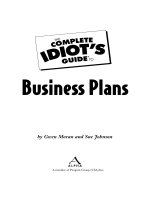the Startup owner''''s manual
Bạn đang xem bản rút gọn của tài liệu. Xem và tải ngay bản đầy đủ của tài liệu tại đây (15.89 MB, 2,287 trang )
“Get Out of the Building!”
The Startup Owner’s Manual
™
The Step-by-Step Guide for Building a Great
Company
by Steve Blank and Bob Dorf
Copyright © 2012 by K and S Ranch Inc., K&S Ranch Publishing
Division
The Startup Owner’s Manual™ TM 2012. All Rights Reserved.
This publication is designed to provide accurate and authoritative in-
formation in regard to the subject matter covered. It is sold with the un-
derstanding that the publisher is not engaged in rendering legal, ac-
counting or other professional services. If legal advice or other expert
assistance is required, the services of a competent professional person
should be sought.
All rights reserved. No part of this publication may be reproduced or
transmitted in any form or by any means, electronic or mechanical, in-
cluding photocopy, recording, or any information storage and retrieval
system, without permission in writing from the publisher. For permis-
sion to copy of any part of the work, contact:
Published by:
K&S Ranch Press, div. K&S Ranch, Inc.
4100 Cabrillo Highway, Pescadero, Califor-
nia 94060
Visit our website at www.steveblank.com.
to contact K&S Ranch, email
Library of Congress Cataloging-in-Publication Data
ISBN: 978-0-9849993-7-8
Book design by Karrie Ross, www.KarrieRoss.com
First Edition: September 2012
5/2287
QED stands for Quality, Excellence and Design. The QED seal of ap-
proval shown here verifies that this eBook has passed a rigorous quality
assurance process and will render well in most eBook reading platforms.
For more information please click here.
6/2287
About this Book
Welcome to The Startup Owner’s Manual e-
book.
Here you’ll find all the tips, techniques and
best practices that entrepreneurs need in
their quest to build successful companies —
packaged to suit your startup team’s particu-
lar path. This e-book organizes The Startup
Owner’s Manual into three e-books to better
help you navigate the text. In short:
• Book 1: The Strategy Guide
provides background on, and an
overview of the Business Model and
Customer Development processes
• Book 2: The Web/Mobile e-book
provides all the step-by-step process
detail you’ll need to create a solid,
sustainable startup doing business in
the web/mobile channel, and
• Book 3: The Physical Channel e-
book offers the same for startups us-
ing physical channels
For best results, start your reading with
the Strategy Guide.
The Startup Owner’s Manual Strategy
Guide makes up the first third of the e-
book. It provides an overview of why star-
tups are not smaller versions of large com-
panies; explains how startups search for a
business model using Customer Develop-
ment; and details the overall customer devel-
opment methodology, and key implementa-
tion steps.
8/2287
For companies with virtual distribution
channels, The Startup Owner’s Manual
for Web/Mobile Channel Startups, the
second part of the e-book, provides a similar
detailed, step-by-step process and approach
for startups that sell via the web or app
stores channels, where things move faster,
customers are abundant, and customer at-
tention is always hard to get.
If you’re building a startup with physical dis-
tribution channels, you’ll want to turn to the
third part of this e-book, The Startup
Owner’s Manual for Physical Channel
Startups. This section provides detailed
guidance, instructions, and examples on how
to build a great company, step-by-step. In-
cluded are details on how to get, keep and
grow your customer base; checklists for
tracking progress; and tools to help determ-
ine just how successful—or not—you can be.
9/2287
We believe the Startup Owner’s Manual can
help you increase your odds of finding cus-
tomers, a market, and product/market fit.
Now, as we say, “get of the building!” And
best of luck with your startup.
Steve and Bob
10/2287
Table of Contents
The Startup Owner’s Manual
Strategy Guide
Title Page
The Startup Owner’s Manual Strategy
Guide Table of Contents
Preface
Who Is This Book For?
Introduction
A Repeatable Path
Why a Second Decade?
The Four Steps: A New Path
Chapter 1:
The Path to Disaster: A Startup Is Not a
Small Version of a Big Company
Chapter 2:
The Path to the Epiphany: The Customer
Development Model
Chapter 3:
The Customer Development Manifesto.
Chapter 4:
An Introduction to Customer Discovery
Chapter 5:
Introduction to Customer Validation
Chapter 6:
Customer Validation: The Toughest
Question of All: Pivot or Proceed?
The Startup Owner’s Manual Strategy Guide
Index
The Startup Owner’s Manual
for Web/Mobile Channel
Startups
Title Page
12/2287
The Startup Owner’s Manual for Web/
Mobile Channel Startups Table of
Contents
How to Read This Book
Getting Started
Chapter 1:
The Customer Development
Manifesto
STEP ONE: Customer Discovery
Chapter 2:
An Introduction to Customer
Discovery
Chapter 3:
Customer Discovery, Phase One:
State Your Business Model
Hypotheses
Chapter 4:
Customer Discovery, Phase Two:
“Get Out of the Building” to Test the
Problem: “Do People Care?”
13/2287
Chapter 5:
Customer Discovery, Phase Three:
“Get Out of the Building” and Test
the Product Solution
Chapter 6:
Customer Discovery, Phase Four:
Verify the Business Model and Pivot
or Proceed
STEP TWO: Customer Validation
Chapter 7:
Introduction to Customer Validation
Chapter 8:
Customer Validation, Phase One:
“Get Ready to Sell”
Chapter 9:
Customer Validation, Phase Two:
“Get Out of the Building and Sell!”
Chapter 10:
Customer Validation, Phase Three:
Develop Product and Company
Positioning
14/2287
Chapter 11:
Customer Validation, Phase Four:
The Toughest Question of All: Pivot
or Proceed?
How to Build a Web Startup: A Simple
Overview
The Startup Owner’s Manual for Web/
Mobile Channel Startups Index
The Startup Owner’s Manual
for Physical Channel
Startups
Title Page
The Startup Owner’s Manual for Phys-
ical Channel Startups Table of
Contents
How to Read This Book
Getting Started
15/2287
Chapter 1:
The Customer Development
Manifesto
STEP ONE: Customer Discovery
Chapter 2:
An Introduction to Customer
Discovery
Chapter 3:
Customer Discovery, Phase One:
State Your Business Model
Hypotheses
Chapter 4:
Customer Discovery, Phase Two:
“Get Out of the Building” to Test the
Problem: “Do People Care?”
Chapter 5:
Customer Discovery, Phase Three:
“Get Out of the Building” and Test
the Product Solution
Chapter 6:
Customer Discovery, Phase Four:
16/2287
Verify the Business Model and Pivot
or Proceed
STEP TWO: Customer Validation
Chapter 7:
Introduction to Customer Validation
Chapter 8:
Customer Validation, Phase One:
“Get Ready to Sell”
Chapter 9:
Customer Validation, Phase Two:
“Get Out of the Building and Sell!”
Chapter 10:
Customer Validation, Phase Three:
Develop Product and Company
Positioning
Chapter 11:
Customer Validation, Phase Four:
The Toughest Question of All: Pivot
or Proceed?
17/2287
The Startup Owner’s Manual for Physical
Channel Startups Index
18/2287
The Startup
Owner’s Manual
Strategy Guide
Table of Contents
Preface
Who Is This Book For?
Introduction
A Repeatable Path
Why a Second Decade?
The Four Steps: A New Path
Chapter 1:
The Path to Disaster: A Startup Is Not a
Small Version of a Big Company
Chapter 2:
The Path to the Epiphany: The Customer
Development Model
Chapter 3:
The Customer Development Manifesto.
Chapter 4:
An Introduction to Customer Discovery
Chapter 5:
Introduction to Customer Validation
Chapter 6:
Customer Validation: The Toughest
Question of All: Pivot or Proceed?
The Startup Owner’s Manual Strategy Guide
Index
21/2287
Preface
IN 1602, THE DUTCH EAST INDIA COMPANY,
generally regarded as the first “modern com-
pany,” issued the first stock certificates. In
the intervening 300 years, companies man-
aged to start, build and grow without form-
ally trained executives. By the 20
th
century,
the complexity of modern corporations de-
manded a cadre of executives trained to ad-
minister large companies. In 1908, Harvard
awarded the first master of business admin-
istration (MBA) degree to fill the need to
bring professional education standards to big
business. The MBA curriculum standardized
and codified the essential elements an oper-
ating executive in a modern company needed
to know: cost accounting, strategy, finance,
product management, engineering, person-
nel management and operations.
Formal management tools
are about 100 years old.
Fast-forward to the mid-20
th
century.
The pairing of venture capital and startup
entrepreneurship emerged in its modern
form, and the startup industry they fostered
has been exploding ever since. Yet for the
past 50 years, finding the successful formula
for repeatable startup success has remained
a black art. Founders have continually
struggled with and adapted the “big busi-
ness” tools, rules and processes taught in
business schools and suggested by their in-
vestors. Investors have been shocked when
startups failed to execute “the plan,” never
23/2287
admitting to the entrepreneurs that no star-
tup executes to its business plan. Today,
after half a century of practice, we know un-
equivocally that the traditional MBA cur-
riculum for running large companies like
IBM, GM and Boeing does not work in star-
tups. In fact, it’s toxic.
With the benefit of hindsight, entre-
preneurs now understand the problem,
namely that startups are not simply smaller
versions of large companies. Companies ex-
ecute business models where customers,
their problems, and necessary product fea-
tures are all “knowns.” In sharp contrast,
startups operate in “search” mode, seeking a
repeatable and profitable business model.
The search for a business model requires
dramatically different rules, roadmaps, skill
sets, and tools in order to minimize risk and
optimize chances for success.
By the beginning of the 21
st
century, en-
trepreneurs, led by web and mobile startups,
24/2287
began to seek and develop their own man-
agement tools. Now, a decade later, a radic-
ally different set of startup tools has
emerged, distinct from those used in large
companies but as comprehensive as the tra-
ditional “MBA Handbook.” The result is the
emerging “science of entrepreneurial man-
agement.” My first book, The Four Steps to
the Epiphany, was one of its first texts. It re-
cognized that the classic books about large-
company management were ill-suited for
early-stage ventures. It offered a reexamina-
tion of the existing product-introduction
process and delineated a radically different
method that brings customers and their
needs headfirst into the process long before
the launch.
We are building the first
management tools specific-
ally for startups.
25/2287









